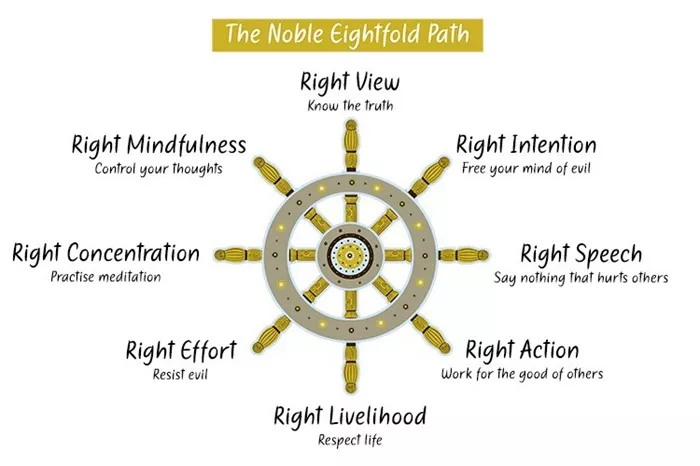The Eightfold Path is a central teaching in Buddhism. It is a guide to ethical and mindful living that helps people reach enlightenment. The Eightfold Path was taught by Gautama Buddha as a way to end suffering. It is also known as the Middle Way because it avoids extreme self-indulgence and extreme self-denial.
The Eightfold Path is part of the Four Noble Truths, which explain suffering and how to overcome it. Each part of the path is important for leading a life of wisdom, morality, and meditation.
The Eightfold Path and Its Meaning
The Eightfold Path consists of eight principles. They are divided into three categories:
Wisdom (Prajna)
Right View
Right Intention
Morality (Sila)
Right Speech
Right Action
Right Livelihood
Meditation (Samadhi)
Right Effort
Right Mindfulness
Right Concentration
Each part of the path supports the others. By practicing all eight principles, a person can live a balanced and meaningful life.
Wisdom (Prajna)
1. Right View (Samma Ditthi)
Right View means understanding the Four Noble Truths. It teaches that:
Life involves suffering (dukkha).
Suffering has a cause (craving and ignorance).
Suffering can end (nirvana).
The way to end suffering is through the Eightfold Path.
A person with Right View sees the world as it really is. They do not hold false beliefs or attachments that cause suffering.
2. Right Intention (Samma Sankappa)
Right Intention is having pure thoughts and motivations. It includes:
Letting go of desire (not being greedy or selfish).
Developing loving-kindness (acting with compassion).
Practicing non-violence (not harming others in thought or action).
Right Intention leads to ethical behavior and a peaceful mind.
Morality (Sila)
3. Right Speech (Samma Vaca)
Right Speech means speaking truthfully and kindly. A Buddhist should avoid:
Lying (saying things that are not true).
Harsh words (insulting or hurting others).
Gossip (spreading rumors or false information).
Idle talk (speaking without purpose).
By practicing Right Speech, a person creates harmony and trust in relationships.
4. Right Action (Samma Kammanta)
Right Action means behaving in a moral and ethical way. Buddhists follow the Five Precepts, which include:
Not killing (respecting all life).
Not stealing (taking only what is given).
Not engaging in sexual misconduct (being faithful and respectful in relationships).
Not lying (being honest in all situations).
Not using intoxicants (avoiding alcohol and drugs that cloud the mind).
Right Action leads to a peaceful and responsible life.
5. Right Livelihood (Samma Ajiva)
Right Livelihood means choosing an ethical job. A Buddhist should not work in professions that:
Harm living beings (such as hunting or butchering).
Involve cheating or dishonesty.
Sell weapons, drugs, or other harmful substances.
Right Livelihood ensures that a person earns a living without harming others.
Meditation (Samadhi)
6. Right Effort (Samma Vayama)
Right Effort means making an effort to develop good qualities. This includes:
Preventing negative thoughts before they arise.
Overcoming bad habits that cause suffering.
Developing positive qualities like patience and kindness.
Maintaining a pure mind by staying mindful.
With Right Effort, a person becomes mentally strong and disciplined.
7. Right Mindfulness (Samma Sati)
Right Mindfulness means being aware of the present moment. This includes:
Being aware of the body (posture, breathing, and actions).
Being aware of feelings (recognizing emotions without attachment).
Being aware of thoughts (observing the mind without judgment).
Mindfulness is practiced through meditation and daily awareness. It helps a person stay calm and focused.
8. Right Concentration (Samma Samadhi)
Right Concentration means developing deep meditation. It involves:
Focusing the mind on a single object (like the breath).
Achieving deep states of concentration (jhana).
Experiencing inner peace and clarity.
Right Concentration helps a person understand the true nature of reality.
The Eightfold Path and the Middle Way
The Eightfold Path is also called the Middle Way. This means it avoids two extremes:
Self-indulgence (seeking pleasure without wisdom).
Self-mortification (harming oneself through extreme practices).
By following the Middle Way, a person can live a balanced and peaceful life.
The Goal of the Eightfold Path
The Eightfold Path leads to nirvana, which is the end of suffering. When a person follows the path, they:
Develop wisdom to see reality as it is.
Practice ethical behavior to live peacefully.
Cultivate meditation to calm the mind.
Nirvana is a state of perfect peace and freedom. It is the ultimate goal of Buddhism.
Conclusion
The Eightfold Path is a complete guide to a meaningful life. It teaches wisdom, morality, and meditation. By following the path, a person can overcome suffering and reach enlightenment.
Buddhists practice the Eightfold Path daily. It helps them develop good qualities and live a peaceful life. Whether Buddhist or not, anyone can follow the path to achieve inner peace and happiness

